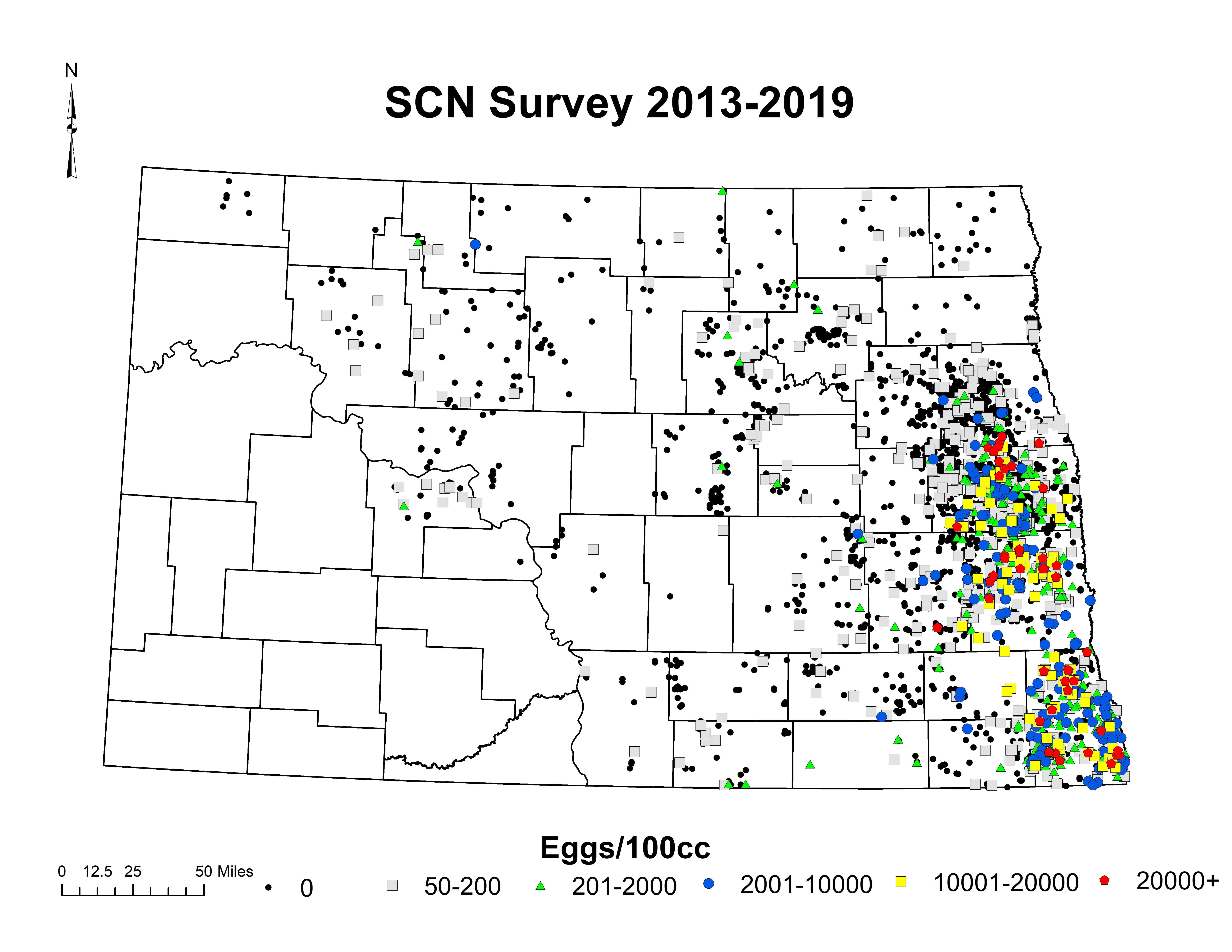
Content and image courtesy of NDSU Extension
Soybean cyst nematode (SCN) is the pathogen most damaging to soybeans, causing at least $1 billion in yield losses in the U.S. annually, and it’s getting worse.
SCN continues to spread in North Dakota and elsewhere in the country. What’s worse, it’s slowly adapting to the genetic resistance used in approximately 95% of the soybeans in the U.S.
The problem is too large and complex for one organization to address alone, so five years ago, North Dakota State University Extension plant pathologist Sam Markell and colleagues from Iowa, Michigan, Wisconsin and Minnesota and a private-sector scientist began developing a plan. That led to the formation of the SCN Coalition, a public-private partnership including major agrochemical companies, two dozen universities and several soybean checkoff organizations that Markell is leading.
“We quickly realized that many growers were largely unaware of how costly SCN could be and that mixed messages on how to manage it were creating confusion,” Markell says.
The SCN Coalition’s goals are to inform producers that the nematode is adapting and encourage producers to manage SCN with soil testing and rotation of crops and soybean genetics, and to consider a nematode-protectant seed treatment.
“SCN can be a huge yield robber,” says Richland County soybean grower Mike Langseth, who is heeding the coalition’s advice. “Since SCN was identified in our area years ago, we have been planting resistant varieties and monitoring the SCN with soil testing. Keeping SCN populations low has limited yield loss on our farm.”
The SCN Coalition was launched in 2018. To date, more than $2.5 million has been committed by soybean checkoff and private industry partners, and the SCN Coalition has raised about an additional $2.5 million of in-kind support.
“The reach of the SCN Coalition is remarkable,” says Ken Nichols, director of research at the North Dakota Soybean Council.
To date, the SCN Coalition has resulted in:
- 429 mentions in national articles
- 16.4% share of the national discussion on SCN
- 18.2 million potential impressions through the ag media
- The SCN Coalition embedding itself in the nation’s largest outdoor and indoor farm shows such as the Commodity Classic and Farm Progress Show
- A special 32-page SCN insert in the Corn+Soybean Digest being distributed to 113,000 growers across the U.S.
- The SCN Coalition being awarded the National Agri-Marketing Association’s Best of NAMA Award for Overall Public Relations Program. NAMA is the largest agri-marketing organization in the U.S.
“The SCN Coalition aligned messaging from the universities, companies and the soybean checkoff,” Nichols says. “The partnership is making an impact on growers across the country and in North Dakota.”
At the state level, NDSU Extension began a statewide SCN sampling program in 2013. The effort is in partnership with the North Dakota Soybean Council, which is covering the laboratory fees.
Each year, the Extension office in every county receives sampling bags and instructions on how to use them. Between 2013 and 2019, about 4,500 fields were sampled. This led to the development of detailed SCN distribution maps.
“Visually, this drives home the message that SCN isn’t an isolated problem on a few acres but a regional challenge affecting every soybean farmer in the region,” says Chandra Langseth, NDSU Extension’s agriculture and natural resources agent in Richland County. “In addition, farmers get their individual field results for the samples they provided.”
Richland County was the first county to have found SCN in North Dakota. That was in 2003.
As part of the effort to combat SCN, NDSU Extension, with support from the North Dakota Soybean Council, has provided several intensive trainings for agents to learn about SCN so they can pass their knowledge on to growers. Teachers at those training events included U.S. experts on SCN. The most recent training was a hands-on course held at Iowa State University specifically for the North Dakota situation.
“The trainings have given me the background to help farmers actively manage SCN on their farms and things to look out for in the future,” Chandra Langseth says.
Surveys have played an important role in the SCN Coalition’s work as well. In 2015, a marketing research firm contacted 1,096 soybean growers in 17 states to document producers’ levels of awareness and active management of SCN. Markell has submitted a proposal to repeat that market research beginning this fall to determine the return on investment and impacts of the SCN Coalition.
Chandra Langseth believes the collaboration among NDSU Extension, the North Dakota Soybean Council and the SCN Coalition is making inroads in the fight against SCN.
“Managing SCN requires a proactive strategy,” she says. “Efforts by NDSU Extension and the North Dakota Soybean Council have increased awareness of SCN levels both on a field and regional scale. Collaboration with other regions is also key for SCN management in North Dakota. The SCN Coalition is a great example of a regional group working alongside farmers to develop the resources needed to best manage SCN.”
Markell agrees.
“When we combine the national presence of the SCN Coalition with the strong local support of the North Dakota Soybean Council, ag companies, NDSU Extension and others, we have a great opportunity to help North Dakota soybean growers,” he says. “We are all working together to save growers money by managing SCN, and the SCN Coalition is a powerful program that is helping us achieve that.”
Visit www.thescncoalition.com to learn more about the SCN Coalition.
